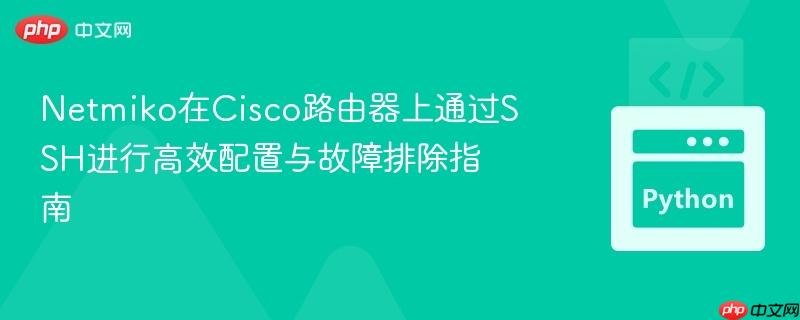
本文详细介绍了如何使用python的netmiko库通过ssh连接cisco路由器并进行配置,重点阐述了netmiko自动处理特权模式和全局配置模式的机制,避免了手动输入`en`和`conf t`的错误。文章还涵盖了接口ip地址、ospf协议及acl的配置方法,并提供了完整的示例代码、配置保存与比较的最佳实践,以及常见的错误处理策略,旨在帮助网络工程师高效自动化cisco设备的管理。
在使用Netmiko库对Cisco设备进行配置时,一个常见的误区是尝试在发送配置命令前手动输入en(enable)和conf t(configure terminal)命令。Netmiko被设计为简化设备自动化,它在建立连接后会自动处理进入特权模式和全局配置模式的步骤。
当您通过ConnectHandler成功连接到Cisco IOS设备并提供secret密码时,Netmiko会自动:
因此,在您通过net_connect.send_config_set()方法发送配置命令列表时,这些命令将直接在全局配置模式下执行,无需在命令列表中包含en或conf t。如果尝试手动发送这些命令,Netmiko可能会因预期外的输出或命令冲突而导致超时错误。
错误示例 (应避免):
loopback_config = [
'en\n' # Netmiko会自动处理
'conf t\n' # Netmiko会自动处理
'interface Loopback0\n',
'ip address 192.168.57.101 255.255.255.0\n',
'exit\n'
]正确的做法是直接提供配置命令,Netmiko将负责将其送达正确的配置模式。
Netmiko通过ConnectHandler类建立与网络设备的连接。为了实现安全的远程管理,通常推荐使用SSH协议。
关键参数:
示例代码片段:
from netmiko import ConnectHandler
import getpass
import logging
logging.basicConfig(level=logging.INFO)
def establish_connection(host, username, password, secret, device_type='cisco_ios', port=22, timeout=60):
"""
建立与Cisco设备的连接。
"""
device = {
'device_type': device_type,
'host': host,
'username': username,
'password': password,
'secret': secret,
'port': port,
'timeout': timeout,
}
try:
net_connect = ConnectHandler(**device)
logging.info('Connection established successfully.')
return net_connect
except Exception as e:
logging.error(f'Failed to establish connection: {e}')
raise
# 在主函数中调用
# net_connect = establish_connection(host, username, password, secret)Netmiko的send_config_set()方法是发送配置命令列表的首选方式。它会逐条发送命令,并等待设备响应,确保命令被正确执行。
配置示例:
Loopback接口是逻辑接口,常用于OSPF等路由协议的Router ID或设备管理地址,其状态始终为UP。
loopback_config = [
'interface Loopback0',
'ip address 192.168.57.101 255.255.255.0',
'no shutdown', # 确保接口开启
'exit'
]配置物理接口需要指定接口名称和IP地址。
interface_config = [
'interface GigabitEthernet0/0',
'ip address 192.168.58.101 255.255.255.0',
'no shutdown',
'exit',
'interface GigabitEthernet0/1',
'ip address 192.168.59.101 255.255.255.0',
'no shutdown',
'exit'
]OSPF(Open Shortest Path First)是一种内部网关协议,用于在大型网络中动态交换路由信息。配置OSPF通常涉及定义进程ID、Router ID(通常是Loopback接口IP)和宣告网络。
ospf_config = [
'router ospf 1', # OSPF进程ID
'router-id 192.168.57.101', # 使用Loopback接口IP作为Router ID
'network 192.168.57.0 0.0.0.255 area 0', # 宣告Loopback网络
'network 192.168.58.0 0.0.0.255 area 0', # 宣告GigabitEthernet0/0网络
'network 192.168.59.0 0.0.0.255 area 0', # 宣告GigabitEthernet0/1网络
'exit'
]ACL用于过滤网络流量,提供安全控制。
acl_config = [
'ip access-list extended MY_ACL',
'permit ip 192.168.56.130 0.0.0.0 any', # 注意:这里原始问题中的掩码是255.255.255.0,但ACL中通常使用反向掩码,0.0.0.0表示精确匹配主机。
# 如果要匹配192.168.56.130/24,则为 permit ip 192.168.56.0 0.0.0.255 any
'deny ip any any',
'exit'
]整合配置并发送: 将所有配置命令列表合并,然后通过send_config_set()发送。
def configure_device(net_connect):
"""
发送配置命令到设备。
"""
loopback_config = [
'interface Loopback0',
'ip address 192.168.57.101 255.255.255.0',
'no shutdown',
'exit'
]
interface_config = [
'interface GigabitEthernet0/0',
'ip address 192.168.58.101 255.255.255.0',
'no shutdown',
'exit',
'interface GigabitEthernet0/1',
'ip address 192.168.59.101 255.255.255.0',
'no shutdown',
'exit'
]
ospf_config = [
'router ospf 1',
'router-id 192.168.57.101',
'network 192.168.57.0 0.0.0.255 area 0',
'network 192.168.58.0 0.0.0.255 area 0',
'network 192.168.59.0 0.0.0.255 area 0',
'exit'
]
acl_config = [
'ip access-list extended MY_ACL',
'permit ip 192.168.56.130 0.0.0.0 any',
'deny ip any any',
'exit'
]
all_configs = loopback_config + interface_config + ospf_config + acl_config
logging.info('Sending configuration commands...')
output = net_connect.send_config_set(all_configs)
print(output)
logging.info('Configuration commands sent.')自动化配置后,验证配置是否成功并持久化非常重要。
使用send_command()获取设备的当前运行配置,并将其保存到本地文件。
def save_config_to_file(config_content, filename):
"""
将配置内容保存到本地文件。
"""
with open(filename, 'w') as f:
f.write(config_content)
logging.info(f'Configuration saved to {filename}')
# 在连接建立后:
# running_configuration = net_connect.send_command('show running-config')
# save_config_to_file(running_configuration, 'router_running_config.txt')比较当前运行配置与之前保存的基线配置(或期望配置)是验证变更的有效手段。Python的difflib库可以帮助实现这一点。
import difflib
def show_differences(config1, config2, label1='Config 1', label2='Config 2'):
"""
显示两个配置字符串之间的差异。
"""
difference = difflib.Differ()
diff = list(difference.compare(config1.splitlines(), config2.splitlines()))
has_diff = False
for line in diff:
if line.startswith('- ') or line.startswith('+ '):
logging.warning(f'Difference found: {line}')
has_diff = True
if not has_diff:
logging.info(f'No significant differences found between {label1} and {label2}.')
return has_diff
# 示例:比较运行配置与本地保存的配置
# if running_configuration and local_config:
# if running_configuration == local_config:
# logging.info('The running configuration is the same as the local configuration.')
# else:
# logging.warning('The running configuration does not match the local configuration:')
# show_differences(local_config, running_configuration, 'Local Config', 'Running Config')Netmiko的ConnectHandler支持上下文管理器(with语句)。使用with语句可以确保连接在代码块执行完毕后自动关闭,即使发生异常也能正确处理,避免了手动调用net_connect.disconnect()可能导致的资源泄露或net_connect未定义错误。
推荐用法:
try:
with ConnectHandler(**device) as net_connect:
logging.info('Connection established')
# 在此处执行所有配置和命令操作
configure_device(net_connect)
# ... 其他操作
except Exception as e:
logging.error(f'An error occurred: {e}')在这种模式下,您无需显式调用net_connect.disconnect()。如果需要显式断开,且确保net_connect已定义,则应将其放在with块内部,例如在所有操作完成后,但在with块结束前。但通常情况下,with语句的自动关闭机制已经足够。
在整个自动化脚本中,应包含健壮的try-except块来捕获可能发生的网络连接问题、认证失败或命令执行错误。
以下是一个整合了上述所有概念的完整Python脚本,用于通过SSH连接Cisco路由器并进行配置、保存和比较。
import logging
import getpass
import difflib
from netmiko import ConnectHandler
# 配置日志
logging.basicConfig(level=logging.INFO, format='%(asctime)s - %(levelname)s - %(message)s')
def save_config_to_file(config_content, filename):
"""
将配置内容保存到本地文件。
"""
try:
with open(filename, 'w') as config_file:
config_file.write(config_content)
logging.info(f'Configuration saved to {filename}')
except IOError as e:
logging.error(f'Failed to save configuration to {filename}: {e}')
def show_differences(config1, config2, label1='Config A', label2='Config B'):
"""
显示两个配置字符串之间的差异。
"""
difference = difflib.Differ()
diff = list(difference.compare(config1.splitlines(), config2.splitlines()))
has_diff = False
for line in diff:
if line.startswith('- ') or line.startswith('+ '):
logging.warning(f'Difference found: {line}')
has_diff = True
if not has_diff:
logging.info(f'No significant differences found between {label1} and {label2}.')
return has_diff
def configure_device(net_connect):
"""
发送预定义的配置命令到设备。
"""
loopback_config = [
'interface Loopback0',
'ip address 192.168.57.101 255.255.255.0',
'no shutdown',
'exit'
]
interface_config = [
'interface GigabitEthernet0/0',
'ip address 192.168.58.101 255.255.255.0',
'no shutdown',
'exit',
'interface GigabitEthernet0/1',
'ip address 192.168.59.101 255.255.255.0',
'no shutdown',
'exit'
]
ospf_config = [
'router ospf 1',
'router-id 192.168.57.101',
'network 192.168.57.0 0.0.0.255 area 0',
'network 192.168.58.0 0.0.0.255 area 0',
'network 192.168.59.0 0.0.0.255 area 0',
'exit'
]
acl_config = [
'ip access-list extended MY_ACL',
'permit ip 192.168.56.130 0.0.0.0 any', # 精确匹配主机
'deny ip any any',
'exit'
]
all_configs = loopback_config + interface_config + ospf_config + acl_config
logging.info('Sending configuration commands...')
try:
output = net_connect.send_config_set(all_configs)
print("\n--- Configuration Output ---\n", output)
logging.info('Configuration commands sent successfully.')
except Exception as e:
logging.error(f'Error sending configuration commands: {e}')
raise # 重新抛出异常,以便主函数捕获
def main():
host = '192.168.56.101' # 请替换为您的Cisco路由器IP地址
username = input('Please enter your username: ')
password = getpass.getpass('Please enter your password: ')
secret = getpass.getpass('Please enter your enable secret: ') # enable密码
# 允许用户选择连接类型,但SSH更推荐
choice = input('Would you like to connect by using telnet or ssh? (ssh/telnet): ').lower()
if choice == 'telnet':
device_type = 'cisco_ios_telnet'
port = 23
elif choice == 'ssh':
device_type = 'cisco_ios'
port = 22
else:
logging.error('Invalid choice. Defaulting to SSH.')
device_type = 'cisco_ios'
port = 22
device = {
'device_type': device_type,
'host': host,
'username': username,
'password': password,
'secret': secret,
'port': port,
'timeout': 100, # 增加超时时间以应对网络延迟或复杂配置
}
try:
# 使用with语句确保连接自动关闭
with ConnectHandler(**device) as net_connect:
logging.info('Connection established to device.')
# 发送配置命令
configure_device(net_connect)
# 获取并保存运行配置
logging.info('Retrieving running configuration...')
running_configuration = net_connect.send_command('show running-config')
if running_configuration:
remote_config_file_name = f'{host}_running_config.txt'
save_config_to_file(running_configuration, remote_config_file_name)
logging.info(f'Running configuration saved to {remote_config_file_name}')
# 尝试加载本地基线配置进行比较
local_config_file_name = 'baseline_config.txt' # 假设存在一个基线配置文件
try:
with open(local_config_file_name, 'r') as local_config_file:
local_config = local_config_file.read()
logging.info('Comparing running configuration with local baseline...')
show_differences(local_config, running_configuration, 'Local Baseline', 'Running Config')
except FileNotFoundError:
logging.warning(f'Local baseline configuration file ({local_config_file_name}) not found. Skipping comparison.')
except Exception as e:
logging.error(f'Error reading local baseline configuration: {e}')
else:
logging.error('Failed to retrieve running configuration from device.')
except Exception as e:
logging.error(f'An error occurred during device interaction: {e}')
finally:
logging.info('The connection process has concluded.')
if __name__ == "__main__":
main()
通过Netmiko库自动化Cisco路由器的配置是一个强大且高效的工具。掌握其核心机制,如自动处理配置模式、正确使用send_config_set()和send_command()方法,以及利用with语句管理连接,是编写健壮自动化脚本的关键。同时,结合日志记录、错误处理、配置保存与比较等最佳实践,可以大大提高网络管理的效率和可靠性。始终确保在生产环境中运行自动化脚本前,在测试环境中进行充分的验证。
以上就是Netmiko在Cisco路由器上通过SSH进行高效配置与故障排除指南的详细内容,更多请关注php中文网其它相关文章!

Copyright 2014-2025 https://www.php.cn/ All Rights Reserved | php.cn | 湘ICP备2023035733号